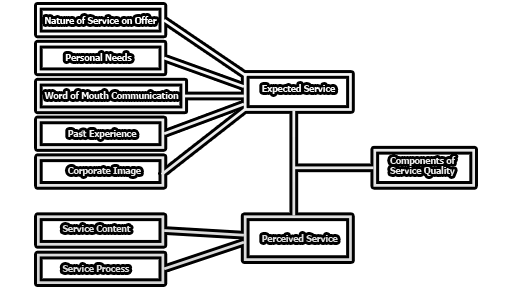Service quality refers to the degree of excellence in the services provided to customers or clients. It reflects the extent to which a service meets or exceeds customer expectations and satisfies their needs. Service quality is often evaluated based on various dimensions such as reliability, responsiveness, empathy, assurance, and tangibles. Reliable service means delivering service as promised and consistently meeting customer expectations. Responsive service means being prompt in responding to customer needs and inquiries. Empathetic service means understanding and caring about the customer’s feelings and needs. Assurance means instilling confidence in the customer through professional competence and courtesy. Tangibles refer to the physical aspects of the service environment, such as facilities, equipment, and appearance. All these dimensions are critical to providing a high level of service quality and ensuring customer satisfaction. In the rest of this article, we are going to know about components of service quality, the role of the customer in deciding service quality, and barriers to service quality
Definitions of Service Quality:
“Service quality refers to the degree to which a service meets or exceeds customer expectations. It is a measure of how well the service is delivered, how responsive the service provider is to the customer’s needs, and how effectively the service is designed to meet the customer’s needs.” – (Investopedia)
“Service quality is the ability of a service to meet or exceed customer expectations. It involves providing services that are reliable, responsive, empathetic, and delivered with assurance. It is about creating an environment where customers feel valued and their needs are understood and addressed.” – (Forbes)
“Service quality refers to the extent to which a service meets the needs and expectations of customers. It is a measure of the performance of a service in terms of its reliability, responsiveness, assurance, empathy, and tangibles. Service quality is crucial for building customer loyalty and satisfaction.” – (BusinessDictionary)
“Service quality is the extent to which a service meets or exceeds customer expectations. It involves providing a service that is reliable, efficient, and effective, as well as being delivered with empathy and assurance. Service quality is essential for creating customer loyalty and building a strong brand reputation.” – (Small Business Trends)
From the above definitions, we can say that service quality is a key factor in customer satisfaction and loyalty, and it involves meeting or exceeding customer expectations through reliable, responsive, empathetic, and assured service delivery.
Components of Service Quality:
Service quality is a critical factor in determining customer satisfaction and loyalty. It refers to how well a service meets or exceeds customer expectations. In order to understand and manage service quality, it is important to identify the components that contribute to it. The two main components of service quality are expected service and perceived service.
- Expected Service: Expected service refers to what the customer anticipates they will receive when using a service. This can be influenced by several factors, including:
- Nature of service on offer: The type of service being offered can impact customer expectations. For example, customers may have different expectations when using a luxury spa service compared to a budget-friendly hair salon.
- Personal needs: The customer’s personal needs and preferences can also influence their expectations. For instance, a customer with sensitive skin may expect a skincare service to use hypoallergenic products.
- Word-of-mouth communication: Word-of-mouth communication, including recommendations from friends and family, can also shape customer expectations. A positive recommendation from a friend may raise a customer’s expectations for service.
- Past experience: A customer’s past experiences with a service can also impact their expectations. If a customer had a positive experience with a service in the past, they may expect similar or even higher levels of quality in the future.
- Corporate image: The brand image and reputation of the company can also impact customer expectations. A well-established and respected brand may raise customer expectations for service.
- Perceived Service: Perceived service refers to how the customer experiences the service they receive. This can be influenced by the service content and service process.
- Service Content: The service content refers to the actual service provided to the customer, such as the quality of the products used, the expertise of the service provider, and the level of personalization. For example, a customer may perceive a spa service to be of high quality if they are provided with high-end products, personalized attention, and knowledgeable service providers.
- Service Process: The service process refers to the way in which the service is delivered to the customer. This can include factors such as the speed of service delivery, the ease of scheduling, and the level of communication between the customer and the service provider. For instance, a customer may perceive a restaurant to have high-quality service if they receive prompt and friendly service, have their order taken accurately, and are kept informed of any delays or issues.
In order to ensure high levels of service quality, businesses need to focus on both expected service and perceived service. By understanding what customers expect from a service and how they perceive it, businesses can identify areas for improvement and implement strategies to meet or exceed customer expectations. This can lead to increased customer satisfaction, loyalty, and ultimately, business success.
Role of Customer in Deciding Service Quality:
Customers play a critical role in deciding the service quality of a business. Here is how the following points relate to the role of customers in determining service quality:
- Reality: Customers are the ones who experience the service and can provide feedback on how well it matches their expectations and needs. Their feedback can help businesses understand the reality of the service they are providing and whether it meets the customer’s expectations. For example, if a restaurant claims to provide fast service but customers frequently experience long wait times, this discrepancy can be addressed by the business through customer feedback.
- Access: Customers can evaluate the ease of accessing a service, whether it is convenient and available when they need it. Their feedback can help businesses improve access and make it more convenient for customers to use their services. For instance, if a retail store only offers online purchasing with long shipping times, customers may provide feedback to the business about the need for a brick-and-mortar location for local pick-up or faster shipping options.
- Security: Customers can provide feedback on the security of the service and whether they feel safe and protected while using it. This can help businesses identify areas of improvement in security measures and build trust with their customers. For example, online retailers may offer two-factor authentication to provide customers with additional security, which could increase customer confidence and overall satisfaction.
- Credibility: Customers can assess the credibility of a service and whether it meets their expectations for reliability and trustworthiness. They can provide feedback on the business’s reputation, reliability, and ability to deliver on promises, which can help build credibility and trust. For example, if a ride-sharing service frequently cancels on customers or overcharges for rides, customers may leave negative feedback and switch to a competitor with better service quality.
- Understanding: Customers can provide feedback on how well the service provider understands their needs and preferences. This can help businesses personalize their services and improve the customer experience. For instance, a hotel may provide guests with a survey upon check-out to understand their preferences for room amenities, such as pillows or bedding, which could increase guest satisfaction and loyalty.
- Responsiveness: Customers can evaluate how responsive a service provider is to their needs and how quickly they address any issues or concerns. This can help businesses improve responsiveness and provide better customer service. For example, a customer service hotline may offer a shorter wait time to customers with urgent issues, which could lead to more positive customer experiences and increased loyalty.
- Competence: Customers can evaluate the competence of service providers in delivering the service and whether they have the necessary skills and expertise. This can help businesses identify areas of improvement and invest in employee training and development. For instance, a car dealership may provide additional training for its mechanics to improve the quality of vehicle repairs, which could lead to more satisfied customers and increased business.
- Courtesy: Customers can evaluate the courtesy and friendliness of service providers and whether they treat customers with respect and professionalism. This can help businesses improve the customer experience and build stronger relationships with customers. For example, a coffee shop may train its baristas to greet customers with a smile and engage in friendly conversation, which could create a more welcoming atmosphere and lead to repeat business.
- Tangibles: Customers can evaluate the physical aspects of the service environment, such as facilities, equipment, and appearance. Their feedback can help businesses improve the tangibles of their service and create a more inviting and comfortable environment. For instance, a gym may invest in new workout equipment or update its locker rooms to improve the overall customer experience and satisfaction.
- Communication: Customers can evaluate how well service providers communicate with them, whether they are clear, concise, and easy to understand. This can help businesses improve communication and ensure that customers have a positive experience while using their services. For example, a telecommunications company may provide clear and concise instructions for troubleshooting issues with their products or services, which could lead to fewer customer frustrations and more positive interactions overall.
Barriers to Service Quality:
There are several barriers that can prevent businesses from providing high-quality services. Some of the barriers are given below:
- Limited resources: Limited resources, such as staff or funding, can make it difficult for businesses to provide high-quality services. For example, if a business is understaffed, service providers may be overworked and unable to provide the level of personalized attention and service that customers expect.
- Inadequate training: Inadequate training can also be a barrier to service quality. If service providers are not properly trained on the products or services they are providing, they may not be able to deliver the level of quality that customers expect.
- Poor communication: Poor communication between the service provider and the customer can also impact service quality. If there is a lack of clear communication about what services will be provided, how long they will take, or what the customer can expect, this can lead to misunderstandings and frustrations.
- Inefficient processes: Inefficient processes can also be a barrier to service quality. For example, if a business has a long wait time or a complicated scheduling process, this can negatively impact the customer experience and perception of service quality.
- Lack of customer focus: A lack of customer focus can also impact service quality. If a business is not customer-centric and does not prioritize the needs and preferences of its customers, this can lead to a disconnect between the service provider and the customer and a lower level of service quality.
- Inadequate feedback mechanisms: Inadequate feedback mechanisms can also prevent businesses from providing high-quality services. If customers are not given an opportunity to provide feedback on their experience, businesses may not be aware of areas for improvement or be able to identify and address service quality issues.
In conclusion, service quality is a critical factor in determining customer satisfaction and loyalty. It encompasses both expected service, which refers to what the customer anticipates they will receive when using a service, and perceived service, which refers to how the customer experiences the service they receive. However, several barriers can prevent businesses from providing high-quality services, including limited resources, inadequate training, poor communication, inefficient processes, lack of customer focus, and inadequate feedback mechanisms. To overcome these barriers and provide high-quality services, businesses must prioritize service quality, focus on improving their processes, train their staff, and foster open communication and feedback mechanisms with their customers. By doing so, businesses can ensure that they meet or exceed customer expectations and improve customer satisfaction and loyalty, leading to business success.
References:
- Parasuraman, A., Zeithaml, V. A., & Berry, L. L. (1985). A conceptual model of service quality and its implications for future research. The Journal of Marketing, 49(4), 41-50.
- Gronroos, C. (1984). A service quality model and its marketing implications. European Journal of Marketing, 18(4), 36-44.
- Zeithaml, V. A., Bitner, M. J., & Gremler, D. D. (2006). Services Marketing: Integrating Customer Focus Across the Firm. New York: McGraw-Hill.
- Bitner, M. J., Booms, B. H., & Tetreault, M. S. (1990). The service encounter: diagnosing favorable and unfavorable incidents. Journal of Marketing, 54(1), 71-84.
- Paraskevas, A., & Arendell, B. (2007). Customer service quality in the Greek Cypriot banking industry. Managing Service Quality: An International Journal, 17(2), 229-244.
- Cronin, J. J., & Taylor, S. A. (1992). Measuring service quality: A reexamination and extension. Journal of Marketing, 56(3), 55-68.
- Johnston, R., & Clark, G. (2008). Service operations management: improving service delivery. Pearson Education.
- Kim, W. G., & Moon, Y. J. (2009). Customers’ cognitive, emotional, and actionable response to the servicescape: A test of the moderating effect of the restaurant type. International Journal of Hospitality Management, 28(1), 144-156.
- Huang, Y. M., & Chang, T. H. (2016). Service quality, customer satisfaction, and customer loyalty in an online reservation system context. Service Business, 10(3), 569-585.
- Paraskevas, A., & Brotherton, B. (2014). Human resource management in the hospitality industry: A guide to best practice. Routledge.

Former Student at Rajshahi University










